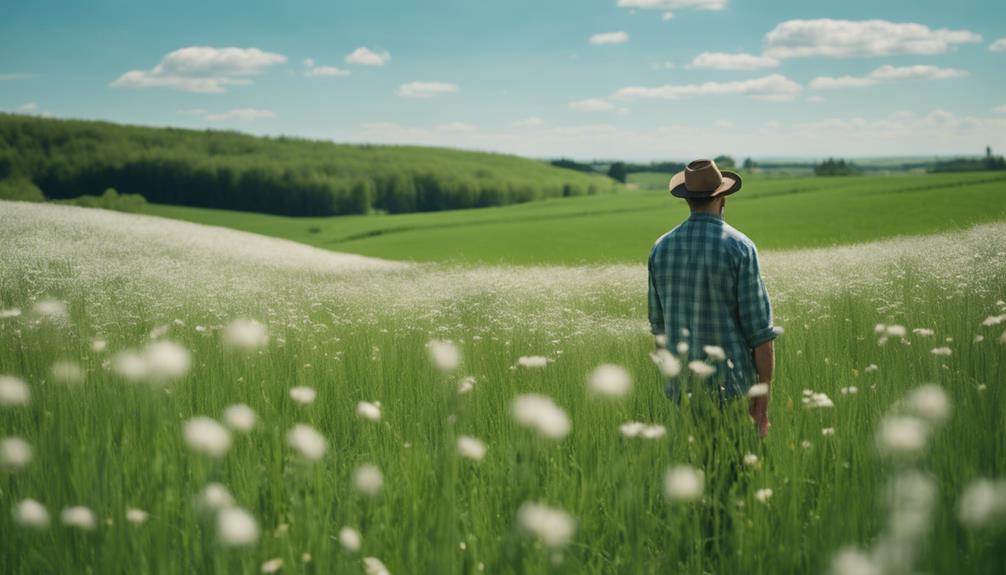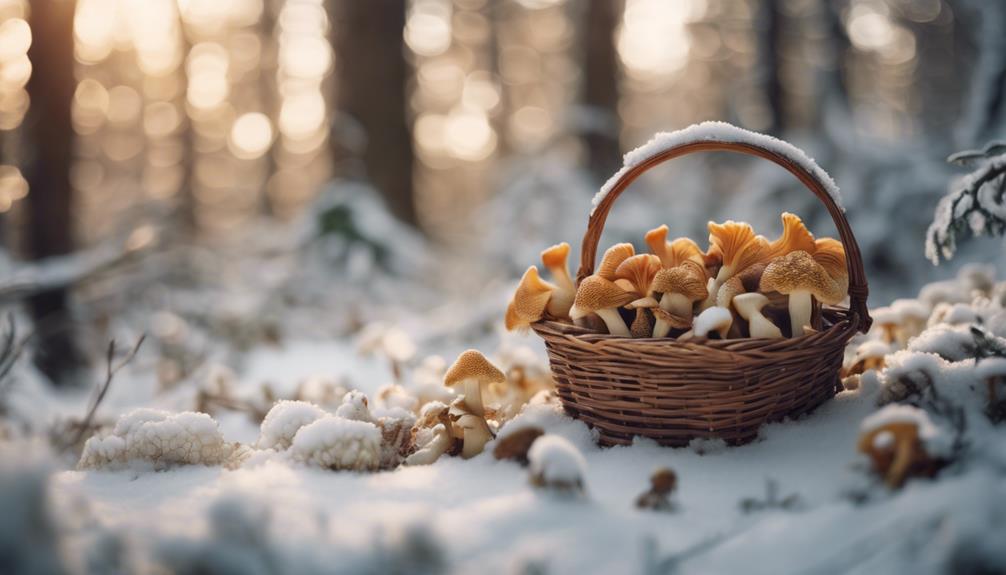You can successfully plant forage oats in the spring, but it's important to understand the specific climate and soil requirements for best growth and yield. Choose an oat variety that aligns with your forage production goals, considering traits like rust resistance. Plant oats at a depth of 1/4 to 1/2 inch, aiming for a seeding rate of 80-100 pounds per acre. Timing is key, as oats prefer cooler temperatures, and you'll want to plan for peak forage supply for growing animals. By understanding these factors, you'll be well on your way to a successful spring oat harvest – and there's more to explore on maximizing your yields.
Key Takeaways
- Forage oats prefer cooler temperatures, making spring planting a suitable option, but warmer weather can cause them to die out before fall hunting season.
- Selecting an oat variety suitable for your climate and soil conditions is crucial for successful spring planting.
- Planting oats at a depth of ¼ to ½ inch and aiming for a seeding rate of 80-100 pounds per acre can ensure optimal emergence and forage production.
- Mixing oats with other forages like chicory or brassicas can enhance growth, longevity, and wildlife support, especially during spring and late summer plantings.
- Timely harvest and grazing management are essential to prevent overgrazing, promote plant recovery, and ensure high-quality oats for animal nutrition needs.
Choosing the Right Oat Variety
When selecting a spring oat variety, you'll want to take into account the specific traits that align with your forage production goals, whether that's high yields, winter hardiness, or rust resistance.
As you navigate the selection process, it's crucial to ponder factors that impact the success of your forage production.
Consulting a team of agronomists can provide valuable insight into the best variety for your specific needs. They can help you weigh the benefits of different options, such as Everleaf 126 Spring Oats, which boast high winter survival rates and potential for high total season yield. Additionally, agronomists can offer expertise on optimizing planting schedules and soil management to maximize crop resilience and output. In some cases, they might also suggest diversifying your farming practices, such as incorporating alternative food sources or even exploring activities like *foraging wild edibles in Michigan*, which can supplement your agricultural efforts with nutrient-rich plants that grow naturally in the region. This holistic approach ensures both sustainability and resourcefulness in meeting your farming goals.
Alternatively, you may find that Canmore Spring Oats, ideal for straw production, better suit your goals. If rust resistance is a top priority, Reeves Spring Oats, an early maturing variety, might be the way to go.
To make sure you're making an informed decision, consider signing up for product selection assistance, which provides seasonal updates and tailored recommendations.
Planting and Seeding Strategies

You'll need to carefully plan your planting and seeding strategies to guarantee peak forage production from your spring oats. When planting spring oats, it's important to get the seeding rate and depth right. Aim for a seeding rate of 80 to 100 pounds per acre, and plant at a depth of ½ to ¾ inch to enhance emergence and forage production potential.
This will help you achieve best growth and maximize your forage supply. With proper planning, you can expect forage production to range from 2500 to 5000 pounds per acre, making it an excellent choice for growing animals.
Keep in mind that spring temperatures can affect germination, so it's vital to conduct a germination test to secure the best results. By following these guidelines, you'll be well on your way to a successful spring oat crop, providing a nutritious forage supply for your animals.
Forage Management Essentials

By planting spring oats, you've taken the first step, but now it's time to focus on forage management essentials to secure a healthy, thriving crop that meets your animals' nutritional needs.
Proper management practices and timely harvest are key for successful forage production with spring-planted oats. Grazing management is vital, with grazing starting at 6 to 8 inches tall and stopping at 2 to 3 inches tall. Careful planning and strategic grazing are needed to prevent overgrazing and promote plant recovery.
Hay production from spring-planted oats should occur at the early heading stage for best yield and quality. You've invested time and resources into planting and seeding, so it's crucial to ensure your forage oats reach their full potential. Effective forage management will help you achieve high-quality oats that meet your animals' nutritional requirements.
Grazing and Hay Production Tips

As you move forward with your spring-planted oats, it's important to focus on ideal grazing and hay production strategies.
You'll want to time your grazing precisely to guarantee the health of your plants, and harvest your oats at the right moment to maximize yield and nutritional value.
Optimal Grazing Timing
Timing your grazing and harvesting correctly is essential for maximizing the productivity of your spring-planted oats. When planting in spring, key grazing timing is vital to guarantee you get the most out of your forage oats.
You should begin grazing when your oats reach 6 to 8 inches in height to maximize forage availability. However, it's equally important to cease grazing when the oats are reduced to 2 to 3 inches in height to promote plant recovery and regrowth. This strategic grazing management will help maintain a healthy forage stand.
Consider implementing rotational grazing practices to ensure adequate rest periods for your oat plants to recover and continue producing quality forage. By doing so, you'll be able to harvest your oats for hay at the early heading stage, when the yield and quality are at their best.
Hay Yield Maximization
You can greatly enhance your hay yield and quality by adopting strategic grazing practices and harvesting your oats at the ideal stage. Timing is everything when it comes to maximizing your hay yield.
Harvesting oats for hay at the early heading stage ensures best yield and quality. If you delay harvest, the nutritive value of oats decreases greatly, impacting hay quality. In fact, research shows that delayed harvest can further reduce the quality of the forage.
Proper grazing management is essential for maximizing hay yield and quality. By implementing strategic grazing practices, you can maintain forage production levels and promote plant recovery. This, in turn, helps to guarantee a bountiful harvest.
Maximizing Spring Oat Yields

As you focus on maximizing spring oat yields, you'll want to contemplate several key factors that can make a significant difference in your harvest.
You'll need to select the right oat variety for your specific climate and soil conditions, prepare your soil properly to support healthy growth, and develop a plan for managing moisture levels.
Oat Variety Selection
When maximizing spring oat yields, selecting the right oat variety is crucial, and there are several top-performing options to contemplate. You'll want to choose a variety that suits your specific climate, soil type, and management practices.
Here are some top oat varieties to ponder for your spring planting:
- Canmore: A medium maturity variety suitable for straw production, offering a balance between yield and quality.
- Everleaf 126: The latest maturing variety, known for its high winter survival rates, ensuring a strong start to your spring oat crop.
- Reeves: An early maturing variety that establishes quickly and boasts rust resistance, making it an excellent choice for areas prone to rust.
Consult with agronomists or local experts to determine the best oat variety for your specific needs. By selecting the right variety, you'll be well on your way to achieving excellent spring oat yields.
Soil Preparation Tips
With your oat variety selected, now it's time to focus on preparing the soil to maximize spring oat yields. Before planting, make sure your soil is ready for best oat growth.
| Soil Condition | Action |
|---|---|
| Soil pH < 6.0 or > 7.0 | Adjust pH level for best oat growth |
| Unknown nutrient levels | Conduct nutrient testing to determine fertilization needs |
| Waterlogged areas | Avoid planting in these areas to prevent root damage |
| Poor soil fertility | Add necessary fertilizers to ensure sufficient soil fertility |
Moisture Management
Properly managing soil moisture is key to maximizing your spring oat yields, and you'll want to keep a close eye on moisture levels to guarantee ideal conditions for germination and early growth. Adequate soil moisture levels are essential for the successful establishment of spring-planted oats.
Here are some essential considerations for effective moisture management:
- Monitor soil moisture regularly to maintain the best conditions for oat establishment and development. Excessive moisture can lead to poor emergence and potential disease issues.
- Implement irrigation practices if necessary to sustain consistent soil moisture levels for healthy oat growth.
- Be prepared to adjust your irrigation schedule according to weather conditions, ensuring that your oats receive the appropriate amount of moisture at the right time.
Overcoming Common Challenges

You'll face unique challenges when planting forage oats in the spring, particularly since they're more sensitive to warmer temperatures. As you plant oats in the spring, you'll need to address these challenges to guarantee their survival and longevity. One major hurdle is warmer weather, which can cause spring-planted oats to die out before fall hunting season. Since forage oats prefer cooler temperatures, it's crucial to take this into account when planting.
To overcome these challenges, contemplate mixing oats with other forages like chicory or brassicas. This can enhance growth and longevity, especially in spring. Here's a comparison of planting oats with different forages:
| Forage | Planting Season | Benefits |
|---|---|---|
| Oats + Chicory | Spring | Better growth, longevity |
| Oats + Brassicas | Late Summer | Supports wildlife, fall hunting |
| Oats alone | Spring | May die out before fall hunting |
| Oats alone | Late Summer | May not establish well |
| Oats + Chicory | Late Summer | Not recommended, chicory prefers cooler temperatures |
Frequently Asked Questions
Can You Plant Forage Oats in the Spring?
You can indeed plant forage oats in the spring, typically between February 15 to March 10, but be aware that yields might be lower than fall-seeded wheat, requiring careful grazing management.
How Late in Spring Can You Plant Oats?
You can plant oats ridiculously late, almost to the point of summer, but realistically, aim for early April, considering regional climate and soil conditions, and you'll still reap a decent forage oat harvest!
When to Plant Buck Forage Oats?
You're wondering when to plant Buck Forage oats. Typically, you'll want to plant them 4-6 weeks before the last frost date in your area, ensuring they'll mature before the hot summer weather sets in.
How Long Does It Take for Forage Oats to Mature?
"Fasten your farmer's hat and focus on forage oats' fate – you'll find they flourish from planting to harvest in about 60 to 90 days, depending on weather, soil, and management mastery."
Conclusion
As you navigate the world of forage oats, remember that you're not just planting seeds, you're cultivating a symphony of growth.
Each step, from choosing the right variety to grazing and hay production, is a deliberate note that harmonizes to create a bountiful harvest.
By following these tips, you'll conduct a masterful performance, overcoming common challenges and maximizing spring oat yields.
Your careful planning and attention to detail will be the melody that brings forth a thriving crop, resonating with success.










